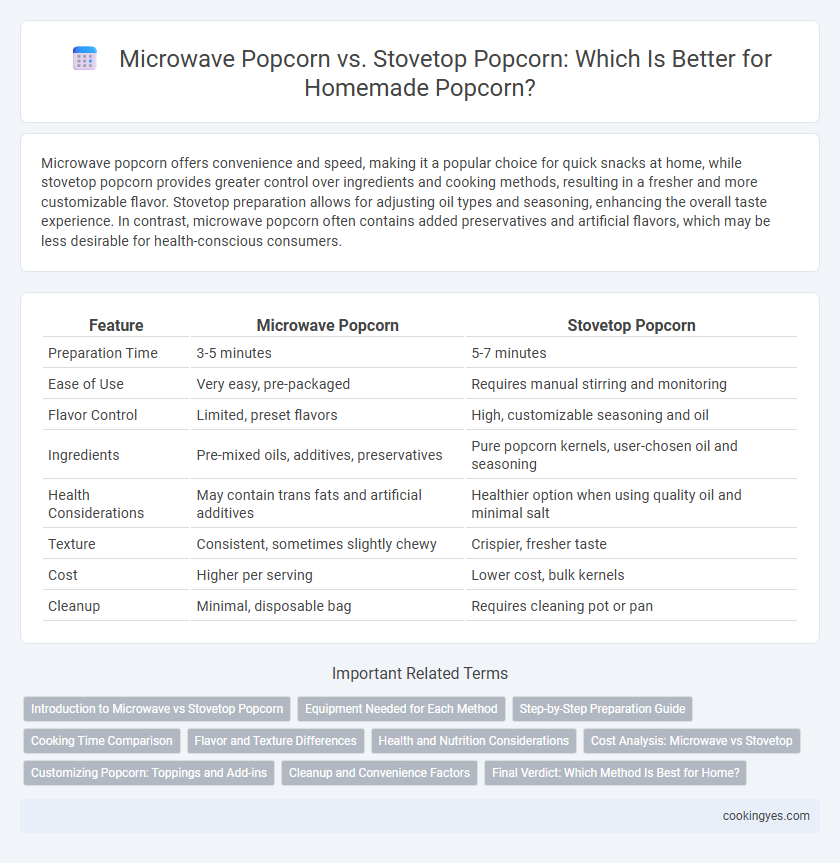Microwave popcorn offers convenience and speed, making it a popular choice for quick snacks at home, while stovetop popcorn provides greater control over ingredients and cooking methods, resulting in a fresher and more customizable flavor. Stovetop preparation allows for adjusting oil types and seasoning, enhancing the overall taste experience. In contrast, microwave popcorn often contains added preservatives and artificial flavors, which may be less desirable for health-conscious consumers.
Table of Comparison
| Feature | Microwave Popcorn | Stovetop Popcorn |
|---|---|---|
| Preparation Time | 3-5 minutes | 5-7 minutes |
| Ease of Use | Very easy, pre-packaged | Requires manual stirring and monitoring |
| Flavor Control | Limited, preset flavors | High, customizable seasoning and oil |
| Ingredients | Pre-mixed oils, additives, preservatives | Pure popcorn kernels, user-chosen oil and seasoning |
| Health Considerations | May contain trans fats and artificial additives | Healthier option when using quality oil and minimal salt |
| Texture | Consistent, sometimes slightly chewy | Crispier, fresher taste |
| Cost | Higher per serving | Lower cost, bulk kernels |
| Cleanup | Minimal, disposable bag | Requires cleaning pot or pan |
Introduction to Microwave vs Stovetop Popcorn
Microwave popcorn offers a quick and convenient option with pre-measured oil and seasoning, ideal for fast home preparation. Stovetop popcorn provides customizable control over oil type, popping temperature, and seasoning, resulting in a fresher, crunchier texture. Both methods yield different flavor profiles and textures, allowing popcorn enthusiasts to choose based on convenience or culinary preference.
Equipment Needed for Each Method
Microwave popcorn requires minimal equipment, typically just a microwave-safe bag or container designed for popping, making it convenient and quick for home use. Stovetop popcorn demands a pot with a heavy bottom and a lid to evenly distribute heat and prevent kernels from escaping, offering more control over popping time and oil usage. Both methods have distinct equipment needs that influence preparation ease, flavor customization, and cleanup.
Step-by-Step Preparation Guide
Microwave popcorn requires removing the bag from the packaging, placing it in the microwave with the correct side up, and heating for 2-4 minutes until popping slows to 1-2 seconds between pops. Stovetop popcorn starts by heating 2-3 tablespoons of oil in a large pot over medium-high heat, adding 1/3 cup of kernels, covering the pot, and shaking it occasionally until popping slows. Both methods emphasize careful timing to prevent burning and deliver fresh, flavorful popcorn at home.
Cooking Time Comparison
Microwave popcorn typically cooks in 2 to 4 minutes, offering a quick and convenient option for home preparation. Stovetop popcorn requires about 5 to 7 minutes, depending on the heat level and quantity, allowing for more control over popping and seasoning. The faster cooking time of microwave popcorn contrasts with the traditional stovetop method, which some prefer for its flavor and texture customization.
Flavor and Texture Differences
Microwave popcorn offers a convenient preparation method with a buttery, often salty flavor and a softer, sometimes uneven texture due to pre-packaged seasoning and oil. Stovetop popcorn provides greater control over ingredients, resulting in a fresher, more robust corn flavor with a crisp, uniformly popped texture from direct oil heating. Flavor depth and crunchiness are typically enhanced in stovetop popcorn, appealing to those seeking a customized and wholesome snack experience.
Health and Nutrition Considerations
Microwave popcorn often contains added preservatives, artificial flavorings, and unhealthy trans fats, potentially impacting heart health and calorie intake. Stovetop popcorn allows control over ingredient quality, reducing exposure to additives and excess sodium by using healthier oils and natural seasonings. Both methods provide whole grain benefits, but stovetop preparation is generally preferred for a cleaner, more nutritious snack.
Cost Analysis: Microwave vs Stovetop
Microwave popcorn typically costs around $0.25 to $0.50 per bag, offering convenience but higher per-serving prices compared to stovetop popcorn, where kernels priced at $1.50 to $3.00 per pound can yield multiple servings at an estimated $0.05 to $0.10 each. Stovetop popcorn requires minimal equipment and oil, making it more cost-effective over time despite the initial investment in a pot or pan. Consumers seeking budget-friendly options should consider stovetop preparation for lower long-term expenses and better value per serving.
Customizing Popcorn: Toppings and Add-ins
Microwave popcorn offers convenience but limits customization options due to pre-packaged seasonings, whereas stovetop popcorn allows for full control over oil type, salt levels, and creative add-ins like herbs, spices, or nutritional yeast. Stovetop preparation enhances flavor versatility and texture, catering to personal taste preferences by adjusting heat and ingredient timing. This method supports a healthier alternative by choosing natural toppings and avoiding artificial preservatives commonly found in microwave popcorn bags.
Cleanup and Convenience Factors
Microwave popcorn offers unmatched convenience with minimal cleanup, as the entire cooking process occurs inside a sealed bag that can be discarded after use. Stovetop popcorn requires handling hot oil and washing pots and utensils, leading to more time-consuming cleanup. Choosing microwave popcorn streamlines home preparation by reducing mess and effort, ideal for quick snacks.
Final Verdict: Which Method Is Best for Home?
Microwave popcorn offers convenience and speed, making it ideal for quick snacks with minimal cleanup, but stovetop popcorn provides superior flavor control and customization through adjustable heat and oil choices. Home preparation benefits from stovetop methods by achieving a fresher crunch and the ability to use natural ingredients, avoiding artificial additives commonly found in microwave bags. For those prioritizing taste and ingredient quality, stovetop popcorn is the best home method, while microwave popcorn suits users seeking fast and easy preparation.
Microwave popcorn vs Stovetop popcorn for home preparation Infographic

 cookingyes.com
cookingyes.com